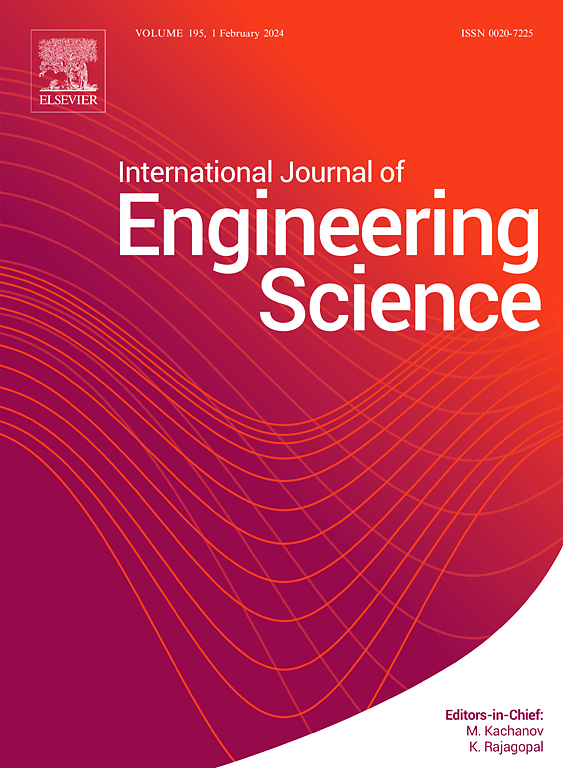柔性纳米颗粒增强复合拉伸传感器机电耦合传感性能的大变形研究
IF 5.7
1区 工程技术
Q1 ENGINEERING, MULTIDISCIPLINARY
International Journal of Engineering Science
Pub Date : 2025-04-12
DOI:10.1016/j.ijengsci.2025.104265
引用次数: 0
摘要
与传统应变传感器在小变形条件下的性能相比,柔性纳米复合材料增强拉伸传感器的大变形分析有待进一步研究。本研究建立了一个扩展的多场耦合均匀化模型来说明柔性纳米颗粒增强复合材料传感器的非线性拉伸传感能力。在本分析中,选择与拉伸相关的伪模量和电导率作为电流拉伸传感分析的双重均匀化参数。在较宽的拉伸载荷范围内,预测的电阻变化率和拉伸敏感系数与纳米银/PDMS纳米复合传感器的实验数据一致。纳米颗粒的形状变形和隧道距离的显著变化是其非线性拉伸传感性能的主要原因。揭示的拉伸传感能力为电子皮肤领域柔性纳米颗粒增强复合材料传感器的优化提供了方向。本文章由计算机程序翻译,如有差异,请以英文原文为准。
A large-deformation investigation into the electromechanically coupled sensing performances of flexible nanoparticle-reinforced composite stretch sensors
In contrast to the conventional strain sensors under the small-deformation condition, the large-deformation analysis on the flexible nanocomposite-reinforced stretch sensors remains to be investigated. In this research, an extended multi-field coupled homogenization model has been developed to illustrate the nonlinear stretch sensing capacities of flexible nanoparticle-reinforced composite sensors. In this analysis, the stretch-dependent pseudo-moduli and conductivity are chosen as the dual homogenization parameters of current stretch sensing analysis. The predicted resistance change ratio and stretch sensitivity factor are consistent with the experimental data of silver nanoparticle/PDMS nanocomposite sensors over a broad range of stretch loading. The nonlinear stretch sensing performance is attributed to the shape deformation of nanoparticles and significant variation of tunneling distance. The uncovered stretch sensing capacities can provide the directions to optimize flexible nanoparticle-reinforced composite sensors in the area of electronic skin.
求助全文
通过发布文献求助,成功后即可免费获取论文全文。
去求助
来源期刊

International Journal of Engineering Science
工程技术-工程:综合
CiteScore
11.80
自引率
16.70%
发文量
86
审稿时长
45 days
期刊介绍:
The International Journal of Engineering Science is not limited to a specific aspect of science and engineering but is instead devoted to a wide range of subfields in the engineering sciences. While it encourages a broad spectrum of contribution in the engineering sciences, its core interest lies in issues concerning material modeling and response. Articles of interdisciplinary nature are particularly welcome.
The primary goal of the new editors is to maintain high quality of publications. There will be a commitment to expediting the time taken for the publication of the papers. The articles that are sent for reviews will have names of the authors deleted with a view towards enhancing the objectivity and fairness of the review process.
Articles that are devoted to the purely mathematical aspects without a discussion of the physical implications of the results or the consideration of specific examples are discouraged. Articles concerning material science should not be limited merely to a description and recording of observations but should contain theoretical or quantitative discussion of the results.
 求助内容:
求助内容: 应助结果提醒方式:
应助结果提醒方式:


